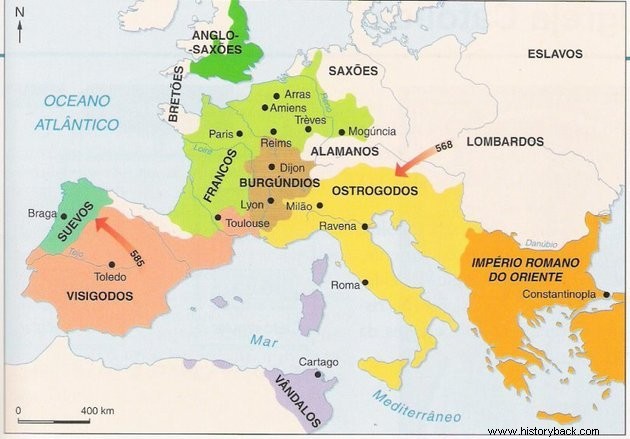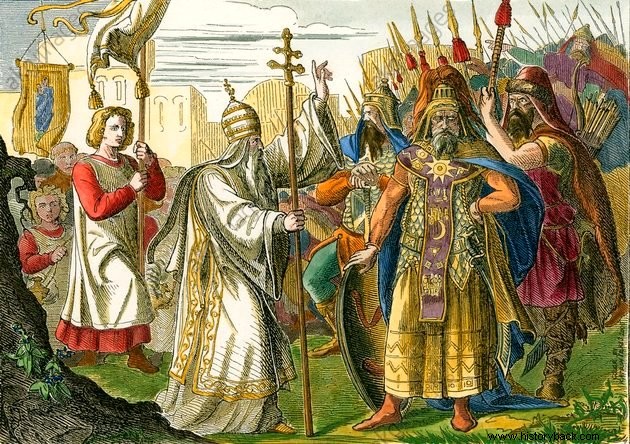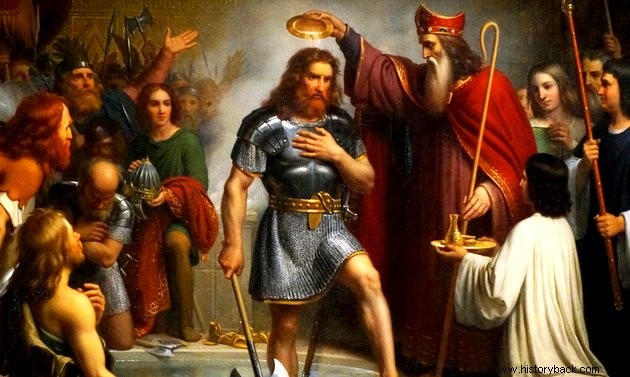The nameBarbarians it was given by the Greeks and Romans to people from northern, western and central Europe.
These had great influence on Europe, as they mixed their customs with those of the Roman Empire.
Origin
The term "barbarian" does not derive from a specific cultural group and was used by the Greeks and Romans to describe cultures they thought were primitive and which based conquests more on physical strength than intellect.
This vision, linked to violence, was extended by the Romans, who began to call peoples who did not share their culture, language and customs "barbarians". Still, the Romans regarded these tribes as fearless and courageous warriors.
Today, the term "barbarian" is applied to describe those who use violence in excess without reflecting on their actions and thus harm other citizens.
Barbarians and the Roman Empire
The Roman Empire spread across Europe and North Africa, conquering various tribes and peoples. Some of these fought violently against the Roman army, which came to classify them as barbarians.
Not always, however, Romans and barbarians were at war. Around the 4th century AD. and V A.D., several tribes were incorporated into the Empire as federates and the Romans recruited young Gothic soldiers and Vandals into their army.
Therefore, several tribes were able to settle within the borders of the Roman Empire.

Goths
The Goths were an East Germanic tribe that originated in Scandinavia. They migrated south and conquered part of the Roman Empire and were a feared people whose prisoners were sacrificed to their god of war, Tyr.
A force of Goths carried out the first attack on the Roman Empire in 263, in Macedonia. They also attacked Greece and Asia, but were defeated a year later and taken back to their homeland by the Danube River.
This people was divided by Roman authors into two branches:the Ostrogoths (Eastern Goths) and the Visigoths (West Goths). The former would occupy the Italian Peninsula and the Balkans, while the latter would occupy the Iberian Peninsula.
See also :Visigoths
Huns

The Huns were a nomadic people from Central Asia who invaded Europe and built a huge empire. They defeated the Ostrogoths and Visigoths and managed to reach the frontier of the Roman Empire.
They were a people feared throughout Europe as exemplary warriors, skilled in archery and horsemanship, and unpredictable in battle.
The only leader who managed to unify them was Attila the Hun or the King of the Huns, and he lived between 406 and 453. He reigned over Central Europe and his empire extended to the Black Sea, River Danube and Baltic Sea.
He was one of the most terrible enemies of the Roman Empire of East and West. He twice invaded the Balkans and came to besiege Constantinople in the second invasion.
Upon arriving at the gates of Rome, Pope Leo I (400-461) convinced him not to seize the city and Attila retreated with his army.
He invaded France, but was repelled at the height of the current city of Orleans. Although Attila did not leave a significant legacy, he became one of Europe's most legendary figures, being known in Western history as the "Scourge of God".
Magyars
The Magyars are an ethnic group originating in Hungary and surrounding areas. They were located east of the Ural Mountains in Siberia, where they hunted and fished. In the region, they still bred horses and developed riding techniques.
They migrated south and west, and in 896, under the leadership of Prince Árpad (850-907), the Magyars crossed the Carpathian Mountains to enter the Carpathian Basin.
Pictos
The Picts were tribes that lived in Caledonia, a region that is now part of Scotland north of the River Forth. Little is known about these people, but it is likely that they shared some gods with the Celts.
They lived north of the Antonine Wall and during the Roman occupation of Britain, the Picts were continually attacked.
His conversion to Christianity takes place in the 6th century, through the preaching of Saint Columba (521-591).
Vandals
The Vandals were an East Germanic tribe that entered the late Roman Empire during the 5th century.
They traveled through Europe until they encountered resistance from the Franks. Although they were victorious, 20,000 Vandals died in the battle and then crossed the river Rhine, invading Gaul where they managed to control the Roman possessions in the north of this territory.
They plundered the peoples they encountered in their path and headed south through Aquitaine. In this way, they crossed the Pyrenees and headed for the Iberian Peninsula. There they settled in various parts of Spain, such as Andalusia in the south, where they settled before leaving for Africa.
In 455, the Vandals attacked and took Rome. They looted the city for two weeks, leaving with countless valuables. The term "vandalism" survives as a legacy of this looting.
See also:Germanic peoplesSuevi
Another tribe from present-day Germany, more precisely from the city of Stuttgart. Unable to face so many battles, the Romans are defeated and hand over the region of Galicia (part of Spain, but also of Portugal) to the Suevi.
Despite the resistance of the Lusitanians, the Suevi established a kingdom in 411 and made the city of Braga, in Portugal, their capital. They will be Christianized in the second half of the 6th century, when King Theodomiro (deceased in 570) ruled.
In 585, the Visigoths defeated them and the Suevi became vassals of the Visigothic kingdom that had its headquarters in Toledo.
Franc

For about 500 years A.D. the Franks ruled over northern France, named after this tribe.
The region was ruled between 481 and 511 by Clovis I (466-511), married to the Catholic princess Clotilde of Burgundy (475-545). Under her influence, Clovis I converted to Christianity and, as was customary at the time, forced his subjects to follow him.
The sovereign's conversion was a step towards the union between the Franks and the Roman Gauls and France became the first Christian kingdom after the Fall of Rome.
In 507, Clovis I issued a set of laws that, among other determinations, placed Paris as the capital of France. Upon dying, he had several descendants who divided the kingdom among themselves.
See also:Kingdom of the Franks
Barbarians in Spain
By the beginning of the 5th century, the Roman Empire was collapsing by the invasion of barbarian peoples. In 409 AD, Alans, Vandals and Suebi occupied most of Spain.
One of the so-called Germanic peoples, the Visigoths, allied with the Romans.
In 416-418, the Visigoths invaded Spain and defeated the Alans, then went to France. The Vandals absorbed the remnants of the Alans, and in 429 they crossed into North Africa, leaving Spain to the Suevi.
Most of the territory that formed Spain fell under the rule of the Visigoths in 456, when the Visigothic king Theodoric II (453-466) led the army and defeated the Suevi.
A small part located in northeastern Spain remained under Roman control, but was dominated by the Visigoths in 476.
Ancient cities that were under Roman rule began to fall under the onslaught of the Visigoths and in 589, King Reccaredo I (559 - 601) converted to Roman Catholicism and thus unified the Spanish-Romans and the Visigoths who lived there.
Later, in 654, King Recesvintus (died 672) drew up a unique code for his kingdom.
Internal disputes between the Visigoths weakened the kingdom, which perished before the Moors. The Visigothic kingdom was destroyed by the Muslim invasion on July 19, 711.
Barbarians in Italy
In the 5th century, the fall of the Roman Empire left Italy fragmented. Between 409 and 407, the Germanic peoples invaded Gaul and in 407, the Roman army left Great Britain.
Three years later, Alaric I the Gothic (370?-410) was captured in Rome, but the empire did not fall.
The downfall was marked between 429 and 430, when Vandals crossed into Spain from North Africa, which was instrumental in the fall of the Romans.
In 455, Rome was sacked by the Vandals and the last Roman Emperor, Romulus Augustus (461-500?) was dethroned in 476.
In this way, the Germanic Odoacer (433?-493) proclaimed himself king of Italy. Odoacer carried out several administrative reforms and managed to dominate the entire peninsula.
Peaceful coexistence between Germans and Romans also continued under the reign of Theodoric (454-526), successor of Odoacer.
The Roman Empire, however, survived in the East and came to be called the Byzantine Empire.
Barbarians in England
Saxons, Angles, Vikings, Danes coming from Scandinavia, began the invasions of Great Britain, in the 3rd century and around the 5th century, taking advantage of the invasions taking place in the Italian Peninsula.
The British Isles were occupied by the Celts and Picts and were always difficult to defend, due to their distance. Therefore, the Romans resorted to hiring mercenaries among the Confederate Germanic peoples, a very common practice at this time.
In this way, more and more barbarian peoples arrived on the islands, defeated the local king and took advantage of the opportunity to settle.
The Celts continued to fight the Anglo-Saxons, but were defeated. Likewise, their religion and customs are gradually absorbed through the Christianization of the British Isles. These facts ended up being the subject of the tales of King Arthur and the Knights of the Round Table.
Read more:
- Middle Ages
- Stonehenge
